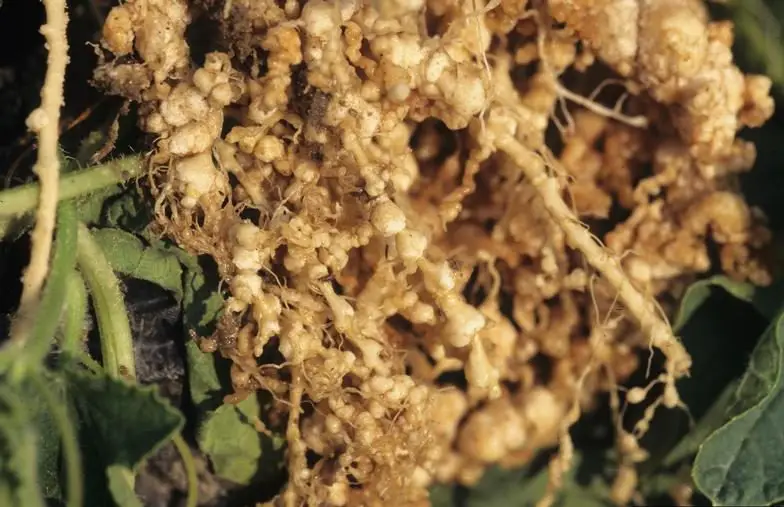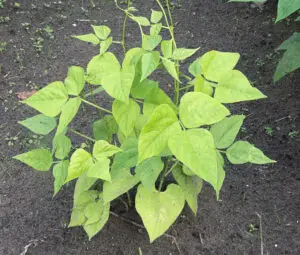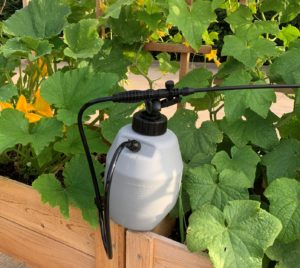Nematodes are microscopic roundworms categorized as either predatory or parasitic. Predatory nematodes hunt down garden pests, like cutworms and squash vine borers, and are considered beneficial by gardeners. On the other hand, parasitic nematodes, like root knot nematodes, feed on plant roots and cause considerable crop damage.
Root knot nematodes attack a wide variety of ornamentals, like morning glories, calendula, and zinnias, as well as vegetable plants, like tomatoes, beets, carrots, peas, lettuce, potatoes, radishes, and more. In addition, they also attack common plants (weeds) such as dandelion and purslane.
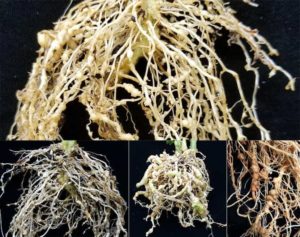
The microscopic worms living in the soil feed on plant roots, releasing chemicals as they move through the root. In defense, the root will form knots or galls in an effort to heal from the damage inflicted by the invading nematodes. The deformed roots are then hindered from taking up water and nutrients, which causes the infected plant to turn yellow or wilt. The galls can also cause stunted growth, lower crop yields, and make the plant more susceptible to disease. Ultimately, the plant may die from the nematode infestation.
The size and severity of the galls depend on the plant variety, nematode species, and the number of nematodes present in the soil. Nematode damage will be less severe in spring when the weather is cool because they are less active in low soil temperatures (60°F; 15°C). However, when temperatures increase in the late spring and through the fall (70°F-85°F; 21°C-30°C), the damage will worsen because they are more active. Thus, summer crops like cucumbers, peppers, tomatoes, squash, okra, and eggplant will be more susceptible to nematode damage than cool weather crops.
Life Cycle of Root Knot Nematodes
Although root knot nematodes are microscopic, their six-stage life cycle is somewhat complex. Female adult nematodes lay upwards of 1,000 eggs either in the soil or inside the root, depending on the species. When hatched, the juvenile nematodes, the majority of which are female, enter the root tip where they begin to feed. They will molt three more times before reaching adulthood. The females continue to feed and lay eggs in the root. Or, in some species, when the female grows large enough, her body will protrude through the root’s surface, and she will lay eggs in the soil. Males, on the other hand, are not confined to the roots but move about in the soil. The entire life cycle takes about thirty days. At the end of the season, any eggs that have not hatched will overwinter in the soil.
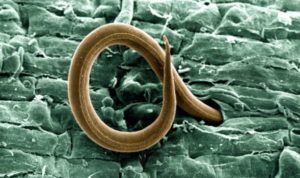
Juveniles can travel short distances where they will infect additional plants, thus spreading the infestation. Root knot nematodes may also spread via water, garden tools, or on the bottom of shoes.
How to Determine If It’s Root Knot Nematodes
Unfortunately, to determine if your languishing plant has root knot nematodes, you will need to pull it up and inspect the root system. Deformed or harry roots, in addition to knots, is a sign they are present. The only way to know for sure, however, is to send a soil sample to your local county or state cooperative extension office who may run a test, or recommend a lab that does.
If you suspect root knot nematodes on your legumes (pea or bean plants), the nodules may actually be nitrogen-fixing bacteria and not the microscopic roundworms. You can distinguish between the two by observing if the knots are loosely attached or if they are a part of the actual root. If they are loosely attached and emit a milky pink-brown liquid when pierced, they are the beneficial bacteria. Conversely, if they appear to be a part of the actual root, then chances are it is evidence of root knot nematodes.

How to Get Rid of Root Knot Nematodes
Treating plants and soil that have been infected with parasitic nematodes can be a somewhat involved process. Nevertheless, the problem must be dealt with, or the negative consequences will multiply as the nematodes multiply. Here are several methods for dealing with root knot nematodes. You will need to layer the methods as employing only one may not be sufficient to eliminate the problem.
Remove Infected Plants – Unfortunately, there is no cure for root knot nematodes once a plant’s roots have been invaded. Once detected, you will have to pull up the infected plants, bag them, and put them in the trash. Do not compost them, as most compost piles do not maintain high enough heat to kill the parasites. Clean any containers, garden tools, equipment, and anything else that has come into contact with the infected soil so that the nematodes won’t be transferred to other areas. You can learn more about disinfecting garden items in this helpful article.
Till the Soil – If you have a traditional garden or you grow in raised beds, experts recommend tilling up the soil to expose the nematodes to the sun and wind, which will dry them out. Remember to sanitize all equipment and tools that you have used in the process. For those who practice no-till gardening or who grow in containers, there are other options below.
Soil Solarization – Once the soil has been tilled, some recommend soil solarization which involves dampening the soil and covering it with a sheet of clear plastic weighted or secured with stakes to keep it from blowing off. The plastic acts as a type of greenhouse, trapping the sun’s heat to kill the nematodes. The process takes four to six weeks if done during the warmer months. Unfortunately, beneficial nematodes, bacteria, and fungi will also die and thus, need to be reintroduced to the soil once the process is complete. Afterward, some recommend leaving the soil fallow for one year to ensure that any remaining nematodes will not have any roots available to lay their eggs.
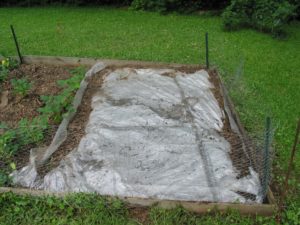
This article contains affiliate links. If you make a purchase using one of these links, I will receive a very small commission at no additional cost to you, and it will help me maintain this website. Rest assured, I only recommend products I actually like!
Use An Organic Nematicide – Here is a list of nematicides that you might want to consider using in your quest to control root knot nematodes. Remember, however, that they will also kill beneficial nematodes.
Geraniol is extracted from the essential oil of certain aromatic plants like germaniums, citronella, lemongrass, and lavender, among others. It is used to control parasitic nematodes by reducing the size of root knots and by killing nematode eggs. Nematode Control by Growers Trust contains geraniol and beneficial bacteria and is said to be an effective treatment. In addition, Eco Clear’s Stop Bugging Me Nematode Control is also said to be effective. It contains geraniol and cinnamon oils.
Saponins are bitter-tasting compounds derived from the Quillaja Saponaria or the soap bark tree, an evergreen that is native to central Chile. Saponins can be used to effectively decrease the nematode population. A product called Monterey Nematode Control uses saponins and is available at some of the big box stores.
Azadirachtin is a naturally occurring compound found in neem oil. You may be familiar with neem oil as I often recommend it for treating aphids, whiteflies, flea beetles, and a host of other garden pests and plant diseases. Neem Bliss contains pure, cold-pressed azadirachtin. It carries the OMRI (Organic Materials Review Institute) seal, which certifies it for use in organic gardens. Azadirachtin works best on root knot nematodes if used early before a serious infestation can occur.
Juglone is a natural compound found in black walnut tree leaves and nut hulls. Juglone works well against root knot nematodes where beets, carrots, parsnips, corn, onions, and squash are growing. However, it can negatively affect other plants and should be used only after the beds have been cleared out. Afterward, use a layer of crushed fresh black walnut leaves and hulls as mulch before replanting. As the material decomposes, the juglone will seep into the soil when you water the area. It will take about six months for the mulch to break down to the point that the juglone is dispersed and no longer a threat to plants.
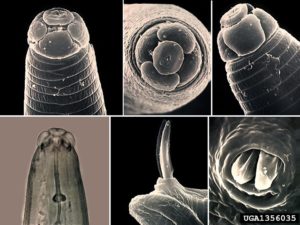
Add Beneficial Microorganisms – The addition of beneficial microorganisms such as mycorrhizal fungi, bacteria, and beneficial nematodes is helpful whether you need to replace those destroyed by soil solarization or simply to increase the number of “good guys” in the fight against harmful nematodes. Down to Earth makes Root Zone which contains granular mycorrhizal fungi and beneficial bacteria. In addition, if you are looking to restore beneficial nematodes, Nature’s Good Guys packages three kinds of beneficial nematodes to help fight root knot galls and other soil problems.
Add Special Fertilizers – There are three natural fertilizers that can help to combat root knot nematodes:
Neem seed meal is the byproduct that results from making neem oil. It adds nitrogen to the soil and helps to strengthen roots and reduce root knot nematodes and other pests by disrupting their life cycle. Down to Earth makes a Neem Seed Meal that has earned a high rating from gardeners.
Crab meal consists of chitin, which is found in crustaceans such as shrimp and crabs. It is also found in the eggshells of nematodes and the exoskeletons of certain insects and fungi. When crab meal (chitin) is applied to the soil, the nematodes, bacteria, and fungi in the soil will feed on it and produce an enzyme called chitinase. When the enzyme is released near nematode eggs, it causes them to hatch prematurely. If the chitin levels are high enough, the adult nematodes’ exoskeletons will also be damaged. Crab meal is also an organic fertilizer containing nitrogen and phosphate. Down to Earth makes an organic Crab Meal Fertilizer that is highly recommended by gardeners interested in getting rid of root knot nematodes.
Oyster shell flour or powder is another option for combating root knot nematodes. Its microscopic jagged edges make it similar to diatomaceous earth. It works by causing abrasions in the nematodes, although its effectiveness is diminished when it becomes wet. Oyster shell also provides calcium and other trace minerals. Down to Earth and Family Farm and Feed make an oyster shell fertilizer that is highly rated.
Plant Resistant Cover Crops – Planting resistant crops is another helpful solution to getting rid of root knot nematodes. For example, corn, clover, wheat, rye, fescue, marigolds, and sudangrass are non-host plants that make good cover crops.
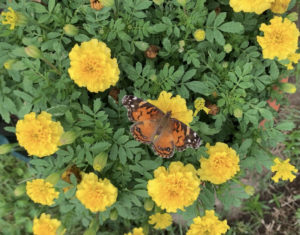
If planted heavily, French marigolds are especially helpful in eliminating nematodes because they release a natural chemical (alpha-terthienyl) into the soil, which is toxic to root knot nematodes. In addition, the marigolds’ roots are difficult for the nematodes to inhabit. When the season is over, it is beneficial to till marigolds into the soil if possible.
Incorporate Organic Matter – Amending the soil with organic matter, such as mature compost, or by allowing compostable materials such as grass clippings and leaves to compost in the soil, can help increase beneficial microorganisms and soil-borne fungi that will, in turn, help control harmful nematodes.
Crop Rotation – Crop rotation is another important factor in eliminating root knot nematodes. Do not plant susceptible crops in the same area where there has been a problem with root galls. Instead, plant resistant crops so that any nematodes in the soil will not have a host plant, and thus, their populations will decrease over time.
Plant Nematode Resistant Seeds – Thankfully, some manufacturers sell root knot nematode-resistant seeds. Look on the seed packet for an “N” or “VFN.” The former signifies that the seeds are nematode resistant, while the latter means they are also some resistance to Verticillium wilt and Fusarium wilt.
Control Weeds – Broadleaf weeds are especially susceptible to root knot nematodes, so be sure to keep your garden weed-free to reduce the likelihood that it will attract these pests.
Maintain a Healthy Garden – Do what you can to maintain a healthy garden, one in which the soil is rich in nutrients and microorganisms and has a balanced soil pH. This will help it be less susceptible to harmful nematodes.
Be Picky About Transplants and Soil – You have worked hard to restore health to your garden soil. Therefore, only introduce plants, transplants, seeds, soils, compost, mulch, and other materials from sources you trust to be free of harmful nematodes.
Root knot nematodes are harmful, microscopic worms that can wreak havoc in your garden. Even though it may be a tedious process, it is important to treat the soil thoroughly if they are discovered.
Thank you for reading this article! If you found it helpful, please consider sharing it with others via email and social media!
